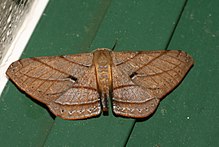HR 3082
HR 3082| 관찰 데이터 Epoch J2000 Equinox J2000 | |
|---|---|
| 콘스텔레이션 | 카멜로파르다리스 |
| 적경 | 08h 04m 47.06842s[1] |
| 적위 | +79°28°46.6073°[1] |
| 겉보기 등급(V) | 5.39[2] |
| 특성. | |
| 스펙트럼형 | A0p[3] Si 또는 B9.5 IV[4] |
| B-V 색지수 | - 0.040±0.002[2] |
| 아스트로메트리 | |
| 반지름 속도(Rv) | +2.7±0.8km[5]/s |
| 고유운동(μ) | RA: - 36.85[1] mas/년 Dec.: - 53.27[1] mas/년 |
| 시차()) | 10.10 ± 0.24 mas[1] |
| 거리 | 323 ± 8 년 (99 ± 2 pc) |
| 절대 등급(MV) | 0.32±0.12[6] |
| 세부 사항 | |
| 덩어리 | 2.65±0.06[6] M☉ |
| 반지름 | 2.89[7] R☉ |
| 광도 | 74+9 −8[6] L☉ |
| 표면 중력(log g) | 3.94±0.14[8] CGS |
| 온도 | 10,795±367[8] K |
| 회전 속도(v sin i) | 30[8] km/s |
| 나이 | 36[8] 미르 |
| 기타 명칭 | |
| 데이터베이스 참조 | |
| 심바디 | 데이터. |
HR 3082는 북반구 극주변 카멜레오파다리스자리에 있는 쌍성이다.겉보기 등급은 5.[2]39로 육안으로 희미하게 보인다.이 시스템은 태양 중심 반경 속도 +2.7km/[5]s로 태양에 가까워지고 있습니다.이 행성은 현재 약 323광년 거리에 있으며, 연간 시차 편이는 10.10±[1]0.24ms이다.
밝은 성분은 스펙트럼에 [10]실리콘이 풍부하게 존재하는 자기성 [7]순한 Ap별입니다.카울리 외 연구진(1969)은 A0p [3]Si로 분류했고, 아브트와 모렐(1995)은 B9.5 [4]IV의 준거성으로 분류했다.질량은 태양의 2.65배[6], 반지름은 태양의 2.89배로[7] 추정된다.이 별은 유효 온도 10,795 [8]K의 광구에서 태양의 74배의 광도를 방출하고[6] 있다.
2009년 [11]기준으로 위치각(PA) 84°에 따라 0.4°의 각도 간격에서 9.6 등급의 별이다.이는 동일한 [12]시선에 위치한 시각적 동반자일 가능성이 높습니다.2016년 [11]기준으로 PA 169°를 따라 6.4º 떨어져 있을 때 등급 13.6의 시각적 동반자가 있다.
레퍼런스
- ^ a b c d e f van Leeuwen, F. (2007), "Validation of the new Hipparcos reduction", Astronomy and Astrophysics, 474 (2): 653–664, arXiv:0708.1752, Bibcode:2007A&A...474..653V, doi:10.1051/0004-6361:20078357, S2CID 18759600.
- ^ a b c Anderson, E.; Francis, Ch. (2012), "XHIP: An extended hipparcos compilation", Astronomy Letters, 38 (5): 331, arXiv:1108.4971, Bibcode:2012AstL...38..331A, doi:10.1134/S1063773712050015, S2CID 119257644.
- ^ a b Cowley, A.; et al. (April 1969), "A study of the bright A stars. I. A catalogue of spectral classifications", Astronomical Journal, 74: 375–406, Bibcode:1969AJ.....74..375C, doi:10.1086/110819
- ^ a b Abt, Helmut A.; Morrell, Nidia I. (July 1995), "The Relation between Rotational Velocities and Spectral Peculiarities among A-Type Stars", Astrophysical Journal Supplement, 99: 135, Bibcode:1995ApJS...99..135A, doi:10.1086/192182.
- ^ a b de Bruijne, J. H. J.; Eilers, A.-C. (October 2012), "Radial velocities for the HIPPARCOS-Gaia Hundred-Thousand-Proper-Motion project", Astronomy & Astrophysics, 546: 14, arXiv:1208.3048, Bibcode:2012A&A...546A..61D, doi:10.1051/0004-6361/201219219, S2CID 59451347, A61.
- ^ a b c d e Kochukhov, O.; Bagnulo, S. (2006), "Evolutionary state of magnetic chemically peculiar stars", Astronomy and Astrophysics, 450 (2): 763, arXiv:astro-ph/0601461, Bibcode:2006A&A...450..763K, doi:10.1051/0004-6361:20054596, S2CID 18596834.
- ^ a b c Shulyak, D.; et al. (September 2014), "Interferometry of chemically peculiar stars: theoretical predictions versus modern observing facilities", Monthly Notices of the Royal Astronomical Society, 443 (2): 1629–1642, arXiv:1406.6093, Bibcode:2014MNRAS.443.1629S, doi:10.1093/mnras/stu1259.
- ^ a b c d e David, Trevor J.; Hillenbrand, Lynne A. (2015), "The Ages of Early-Type Stars: Strömgren Photometric Methods Calibrated, Validated, Tested, and Applied to Hosts and Prospective Hosts of Directly Imaged Exoplanets", The Astrophysical Journal, 804 (2): 146, arXiv:1501.03154, Bibcode:2015ApJ...804..146D, doi:10.1088/0004-637X/804/2/146, S2CID 33401607.
- ^ "HD 49878". SIMBAD. Centre de données astronomiques de Strasbourg. Retrieved 2018-06-06.
- ^ Adelman, S. J. (September 1982), "Spectrophotometry of peculiar B and A stars. XII - HD 10783, 56 Tauri, HD 43819, 53 Aurigae, 49 Camelopardalis, HD 64486, HD 147550, HD 184905 and HD 192913", Astronomy and Astrophysics Supplement Series, 49: 663–672, Bibcode:1982A&AS...49..663A.
- ^ a b Mason, B. D.; et al. (2014), "The Washington Visual Double Star Catalog", The Astronomical Journal, 122 (6): 3466–3471, Bibcode:2001AJ....122.3466M, doi:10.1086/323920.
- ^ Eggleton, P. P.; Tokovinin, A. A. (September 2008), "A catalogue of multiplicity among bright stellar systems", Monthly Notices of the Royal Astronomical Society, 389 (2): 869–879, arXiv:0806.2878, Bibcode:2008MNRAS.389..869E, doi:10.1111/j.1365-2966.2008.13596.x, S2CID 14878976.


